Saddle Theory: Part III
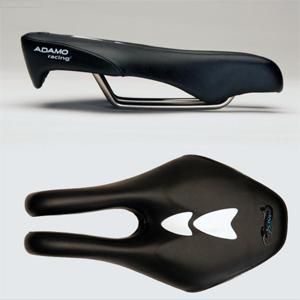
Split nose saddles. I separate these into two categories. There are saddles that would appear pretty much like standard saddles, but, the longitudinal hole or pocket that's featured in many saddles travels all the way to the nose of the saddle, creating a "fjord" out of what in other saddles is a "lake".
Examples of this type of saddle are Koobi and SMP. The SMP's "twin noses" do eventually reattach, but not until they dive a few centimeters in elevation, creating what appears and feels—to your trunk—like a split nose. Likewise certain saddles by Cobb produce the effect of twin noses, because the reattachment of the noses occurs below the raised padding in a V Flow Plus or Max, so that your trunk never touches the point of reattachment.
The width of the nose (or noses), in the aggregate—the entire width of the construct in the front of the saddle—is much less than the width of, say, an ISM Adamo saddle. Because of this, you'd ride a Koobi or SMP pretty much as you would a regular saddle. The front of the saddle protrudes between your thighs, just as any standard saddle.
An ISM Adamo (pictured above) is a different animal altogether. The width of that saddle, at the nose, is considerably greater than on a Koobi. Triathletes do not sit on this saddle as they would a regular saddle. Rather, you'll "hook" your ischeal tuberosities (your sit bones) on the twin noses of an ISM. There is nothing protruding through your thighs. You're going commando on an ISM. Your boys are truly free.
But I must digress ("What?" you ask, dumbfounded. "Slowman digress?!")
THE SADDLE DEBATE
Maybe the most famous, or infamous, study on the danger bicycle saddles represent to males is Lowe, et al, Effect of Bicycle Saddle Designs on the Pressure to the Perineum of the Bicyclist [Official Journal of the American College of Sports Medicine: 2004]. But it's by no means the first or the only. Lowe's references include a list of earlier studies and citations, and there have been citations since.
These studies taken together are not universal in concluding that bicycle saddles cause or contribute to male impotence. Nevertheless, saddle designers have bent over backwards to produce models that, as you bend over forwards, relieve pressure on the perineum, also affectionately known as the "taint" for reasons I will not explore here.
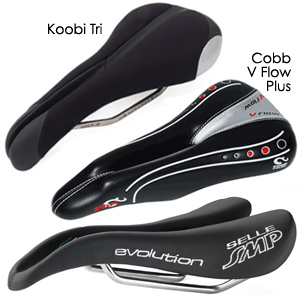
What I find curiously lacking is similar medical explorations of any conflation of bicycle saddles and symmetrical pathologies in women. Women do not have taints. But they do share with men the pudental nerve that enervates the external genitalia of both sexes, and they do suffer from pain in an ill-fitting saddle to degrees at least equal to men. Anyway…
In the case of each gender, saddle pain is bad, and is to be avoided. In the case of men, we do have an additional proxy, or "canary in the coal mine", that may serve to warn us of a potential problem before the onset of pain. Numbness.
It did not take the recent great awakening of urologists to alert us to this problem. It's called, in cycling parlance, "sleepy pee pee". Because we men all have our canaries at the ready, it's pretty easy to know, fairly early on, whether a saddle works for us or not. While you're riding, grab your canary. If it is not numb, and does not cause you pain, I'm no neurologist but I provisionally declare you good to go.
Was that so difficult? (You can let go of your canary now.)
In case you're wondering, my recommended "treatment" for "bicycle seat neuropathy"—finding a saddle that works, tilting the nose marginally down—seems the standard treatment. Unfortunately, I do not find that urologists qualify the suggestion to change the saddle tilt, probably because they're urologists and not orthopedists (practicing cycling medicine without being a doctor is bad; practicing cycling medicine without being a cyclist is just about as bad). See Saddle Theory: Part II for instruction on saddle tilt adjustment (the idea is to make your canary happy without blowing out your patellar tendon, which certainly can happen with a saddle nose tilted down too much.
ABOARD OR ASIDE?
The split rail saddles made today, along with those featuring a hole in the center of the saddle, or a depression or trough, all make an assumption that a man's perineum rests squarely atop the saddle. I don't know that this is a safe assumption. Just as a man is "positioned" to one side or the other when he pulls on his pants every morning, many choose to ride their bikes that way.
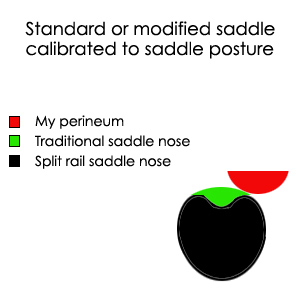
Count me among them, in particular while riding my road race bike with a road race saddle. Accordingly, if the split in the saddle occurs in the nose rather than in the rear, then, like the image adjacent my perineum isn't sitting on the side of the nose, rather it's sitting right on one of the two "peaks" on the nose.
It just depends on the profile of the saddle. Some saddles are really wide in the nose, and the nose is dominated by the "taint pocket" . Other saddles have a more traditional shape, just with a split down the middle of the nose. I can't ride the former, but I can ride the latter, if the entire width of the saddle is not too extreme. A Koobi Enduro is an example and is pictured above along with two other saddles that feature "narrow" split noses.
When I'm riding in the middle or to the rear of the saddle, I'm more square in the saddle. It's when I'm riding on the nose that I favor one side. As a result, and when I'm riding a road saddle on my road bike, saddles that have a split or pocket in the nose do me no good (they may or may not to me ill, but the point of the split nose is irrelevant to me when I'm riding my road bike saddle on its nose).
But the pocket or split in the middle of my road race saddle can provide me a benefit. The saddles by Specialized, such as the Toupe (pictured below), are made this way. My taint likes the saddle when I'm sitting in the neutral or rear position, but it also likes the lack of a split or pocket when I'm on the nose of the saddle.
However, this is just me. If you sit square in the saddle—if your perineum is positioned right on the saddle even when you're on the nose—then the split nose saddles made a lot of sense, both for road and for tri.
Tri riding—and as discussed in Part II of this series—does not feature a lot of movement on the saddle. A saddle's nose is what matters. Because I ride astride the nose rather than right atop it, a split nose does me no advantage. Rather, padding is what helps. Lots of gel. The gel increases the surface area of the contact patch. The more contact, the more displaced the weight.
But I'm in the minority. I find that most people do not like the sort of tri saddle I like. A split nose saddle is therefore quite useful for those who ride differently than do I.
A note about Cobb's V Flow, Plus and Max saddles: While I stand by what I describe above regarding the shape of these saddles, there's a separate reason for the shape. The reason the nose of the saddle dips below the twin padded sections on each side is to provide an air scoop to cool your canary (or, for you ladies, your canary analog). Thirty years ago Selle Italia debuted the Turbo saddle. But these Cobb saddles are the real turbo. To the degree cooling that area is of value, this is the feature Cobb saddles provide that differentiates them from all others.
WIDE SPLIT NOSE
The Koobi, with an actual split nose, and (certain) Cobb and (all) SMP saddles, with a faux split nose, bear absolutely no resemblance to the ISM Adamo or (certain) Dash saddles, that feature a wide split nose. These saddles with the wide split nose are not meant to be ridden with the nose(s) protruding through your thighs, rather you simply rest your sit bones atop the twin noses.
You can't do this with the narrow split nose saddles, because your ischeal tuberosities sit wider than the width of the twin noses in the narrower versions of these saddles. But in the case of the ISMs and the Dash saddles, there is no way you could force your thighs around these things. Many people who dislike ISMs try to mount them like a horse saddle and it's no wonder they're not comfortable.
The saddles by Dash (pictured and mentioned in Part II of this series) correctly understand that about a third of the ISM (the rear third) is useless. So, why should it be there at all? And the Dash saddles just removes it altogether.
A side note about the Dash versus ISM: One of the features of the ISM that separates it from other saddles is that it separates. The "noses" are not bridged, so, during the pedal stroke each left and right "nose" depresses and returns individually. The Dash is bridged, so, while it feels like an ISM when you first get aboard, will it provide the comfort that ISM-philes have come to enjoy? I don't know. I've never ridden a Dash.
I have not yet found a saddle of this sort that I prefer for my own riding. But then I don't walk around commando either. Freedom's just another word for nothing left to lose.
I find that I do suffer from a pressure problem on these kinds of saddles—pressure on my ischeal tuberosities—and it affects the performance of my hamstrings. Of note, the long head of the biceps femoris and the semitendinosis originates from your sit bones, so, if your sit bones are not happy, your hamstrings are likely to be unhappy.
With the view above I am probably in the minority. The last time we polled Slowtwitchers about tri bike saddles, 9 months ago, 31 percent of you said that you suspect you'd be happiest aboard an ISM Adamo saddle. 26 percent of you chose Cobb saddles. Next in line was the Fi'zi:k Arione Tri 2, with 17 percent. This is a big departure a couple of years ago, when Fi'zi:k had a stranglehold on the tri saddle market.
It should also be noted that the saddle tilt on an ISM makes a difference. Most folks find that a slight downward tilt in the plane of the ISM's upper works nicely. If you mount that saddle with the rails level—rather than the upper level—then the saddle does not create the problem I describe above. Accordingly, in the picture at the top of this article, you'll see an ISM Racing II in profile. This is how the saddle should be mounted, according to many ISM-philes. Just like this. Rails parallel to the horizon.
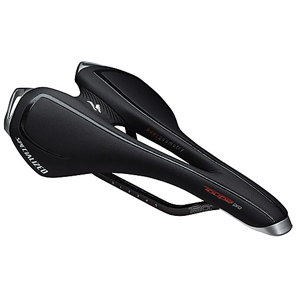
One more note on ISMs: Because your hips reside "in front of" the saddle, rather than atop the saddle, your body position is much steeper than would be the case on a standard saddle. The difference is 2 to 3 degrees. So, if I measure the seat angle of a bike position by drawing a line intersecting both the bottom bracket and the center of the saddle's rails, I'm going to ride my own bike with that line sitting at about 79.5° of seat angle. That's me I'm talking about, not you. You might choose 80°, or 78°, or something else.
However, if I take that saddle off my bike and replace it with a Dash or ISM, I'm setting this up so that the saddle sits at about 77° of inclination, if that line is passing through the BB and the center of the rails.
SADDLES AND SEAT ANGLES
Let's explore this theme a little more, and expand it to include saddles in general. The saddle you choose may work, or may not work, based on the max forward protrusion of your seat post clamp on your bike. What in hell do I mean by that? I'll tell you.
While it should undoubtedly be evident to all by now, at this late date, that 79° is dead center where the tri market is right now, as regards seat angle, there are still some bike makers who either have not gotten that memo, or are still working off old molds. In this case, when you push the saddle all the way forward on the seat post hardware, you may not be able to get the saddle steep enough for your own personal riding preference.
In this case, the saddle can make all the difference. For example, the wide split nose saddles are a great option, because they add about 3 degrees of seat angle to the max angle the bike itself grants you. If you want to ride at 80° but your bike does not give you more than 77° of adjustability, slap an ISM on there. This works great, as long as you're comfortable aboard the ISM.
Otherwise, the metric to consider is the distance between the rearward part of the straight section of the rails and the forward-most protrusion of the sitting area. This distance determines how far in front of the bike's seat post hardware you can sit.
This is an easy metric to measure. Look on the saddle, locate the forward-most place on the saddle you can sit, measure back to the rearmost point of the saddle rail's straight section. Measure. If getting steep enough on your existing bike is a concern, choose a saddle that'll fix the steepness problem for you, as long as it also fixes the point tenderness problem as well.


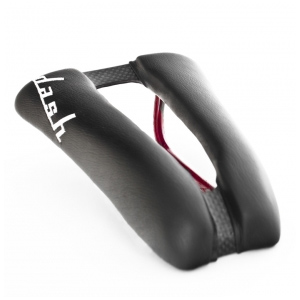
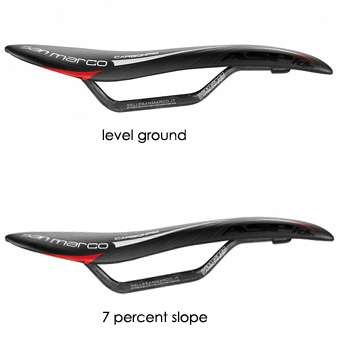
Start the discussion at slowtwitch.northend.network